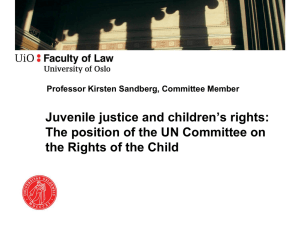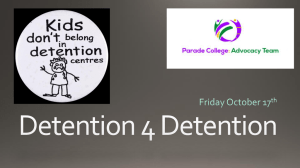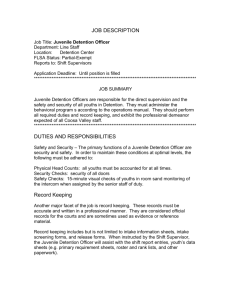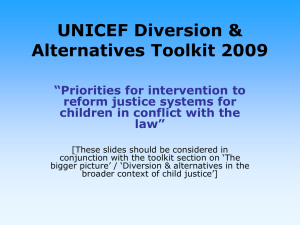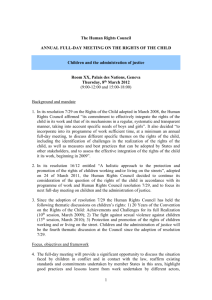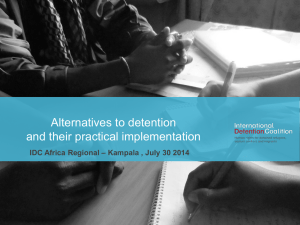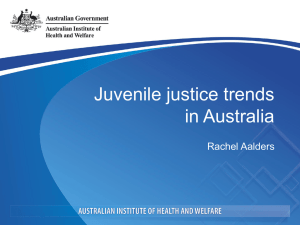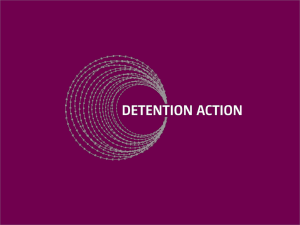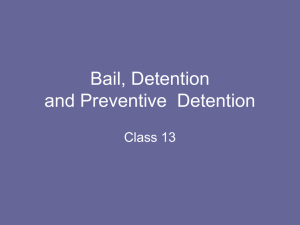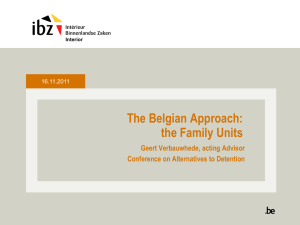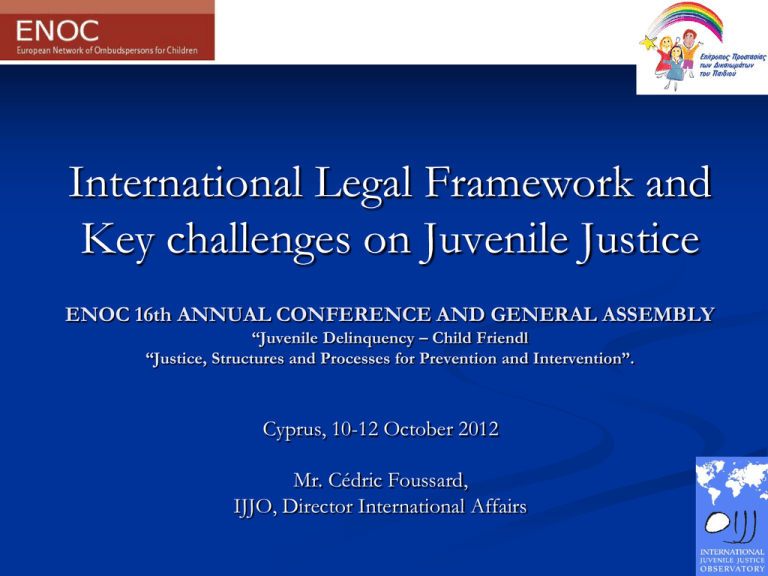
International Legal Framework and
Key challenges on Juvenile Justice
ENOC 16th ANNUAL CONFERENCE AND GENERAL ASSEMBLY
“Juvenile Delinquency – Child Friendl
“Justice, Structures and Processes for Prevention and Intervention”.
Cyprus, 10-12 October 2012
Mr. Cédric Foussard,
IJJO, Director International Affairs
Objectives
Introducing important elements of international
standards concerning juvenile justice focusing on the
conditions of detention
Introducing key challenges on juvenile justice systems
Juvenile Justice Legal Instruments
Convention on the Rights of the Child (CRC) (1989)
UN Standard Minimum Rules for the Administration of Juvenile Justice
(Beijing Rules) (1985)
Convention against Torture (CAT) (1984; 1987)
UN Rules for the Protection of Juveniles Deprived of their Liberty (Havana
Rules) (1990)
UN Standard Minimum Rules for Non-custodial Measures (Tokyo Rules)
(1990)
UN Guidelines for the Prevention of Juvenile Delinquency (Riyadh
Guidelines) (1990)
Guidelines for Action on Children in the Criminal Justice System (Vienna
Guidelines) (1997)
ILO Convention 182 concerning the Elimination and immediate
prohibition of the Worst Forms of Child Labour (Convention 182) (1999)
Optional Protocol to the Convention against Torture (OPCAT) (2006)
UN Rules for the Treatment of Women Prisoners and Non-custodial
Measures for Women Offenders (Bangkok Rules) (2010)
CRC Provisions related to Juvenile
Justice
Article 37
(a) : Neither capital punishment nor life imprisonment
(b) : Detention only as a measure of last resort and for the shortest
appropriate period time
(c) : Separated from adults, maintain contact with family
(d) : Prompt access to legal and other appropriate assistance
Article 39
Promote physical and psychological recover and social reintegration of
a child
Child’s right to survival and development (Article 6)
Right to participation (Article 12)
Conditions of Detention
Conditions of Detention
1. Rehabilitation and Reintegration
The primary purpose of detention must be the rehabilitation and
reintegration of child rather than retribution or the protection of
society
children must receive “care, protection and all necessary individual
assistance that they may require in view of their age, sex and personality”
in order to benefit from rehabilitation and successfully reintegrate into
society. (BR 13.5 )
States should review sentences on a regular basis and determine
whether further detention is necessary. (BR28)
Conditions of Detention
2. Separation from Adults and Opposite Sex
Specifically designed for persons of their respective age unless it is
not in their best interest (CRC 37(c))
Male and female juveniles to be detained separately (BR26.4, Bangkok
Rules 36-39)
3. Living Conditions
Sleeping accommodations that should be unobtrusively supervised
Bedding appropriate for the climate
Storage and sanitary facilities
Personal clothing
Adequate food and drinking water (Section D of the HR)
Conditions of Detention
4.
Contact with the Outside World
5.
Healthcare Services
6.
Right to maintain contact with his/her family through correspondence
and visits (CRC 37(c))
An integral part of the right to fair and human treatment and is essential
to the preparation of juveniles for their return to society (HR 59)
Encourage States to decentralise institutions (HR 30)
Right to enjoy the highest attainable standards of health and to facilities
for the treatment of illness and rehabilitation (CRC 24)
Education, Vocational Training , Labour Opportunities
Children in detention facilities receive the same standard of education
as their counterparts in the community (HR 38)
Right to receive vocational training to prepare for future employment
(HR 42)
7.
Conditions of Detention
Exercise and Recreational Activities
8.
Right to a suitable amount of time for daily free exercise (HR 47)
Provide adequate space, installations and equipment for recreational,
physical and leisure activities (HR 47)
Religion and Culture
Should be allowed to satisfy the needs of his or her religious and
spiritual life, attending the services, possession of the necessary books
or item of religious observance (HR 43)
9. Admission, Registration , and Records
A complete and secure record of these information should be kept:
(a) Information on the identity of the child;
(b) the fact of and reasons for commitment and the authority therefore;
(c) the day and hour of admission, transfer and release;
(d) details of the notifications to parents and guardians on every admission, transfer or
release of the child;
(e) details of known physical and mental health problems, including drug and alcohol abuse
(HR 21)
Conditions of Detention
10. Disciplinary Measures
No child shall be subjected to torture or other cruel, inhumane or
degrading treatment or punishment (CRC 37(a) )
Punishment that may comprise the physical or mental health of
children to be abolished (HR 67-68)
Restrict the use of restraints and the use of force against children in all
forms of detention (HR Sec K)
11. Request and Complain Mechanism
Right to make requests or complaints to the director of the detention
facility and to his/her authorised representative (HR75)
12. Detention Facility Staff
Staff should be professionally trained in order to carry out their
responsibilities effectively (HR Sec V)
Key Challenges
Key Challenges
1. Lack of Data and Statistics
A common challenge faced by many countries
Pre-requisite for the development of sound policies and programmes
aimed to promote juvenile justice
2. Lack of Specialized Juvenile Justice Systems
Inadequate legal and policy framework
Inadequate organization and operational frameworks
3. Increasing Number of Children in Detention
Punitive approaches
Increasing number of children
Majority is charged with petty crimes, first-time offenders
Key Challenges
4. Poor Conditions of Facilities
Lack of adequate space, lack of natural light and fresh air
5. Poor Healthcare Services
Generally substandard, underfunded and a shortage of
staff and basic medications
Risk of spreading transmissible diseases
6. Treatment of Girls in Detention
Minority but deserve special protection
Often held together with adult women
Key Challenges
7. Lack of Social Reintegration Programmes and
Services
Primary purpose must be the rehabilitation and reintegration
Inadequate recognition of the importance coupled with a lack of
resources
8. Lack of Monitoring Mechanism
Essential to prevent violence, inhumane treatment and poor living
conditions
Often closed to outside scrutiny
9. Violence in Detention Facilities
By staff, adult detainees, other child detainees and self-harm
Key Challenges
10. Low Priority
Does not appear to receive high attention by States
Allocated money generally be used to improve security, with very
inadequate investment being made for social integration
11. Inadequate Staffing
Unqualified and poorly remunerated staff
Lack adequate knowledge of child and youth care practices
12. Lack of inter-institutional communication
Lack of adequate coordination and cooperation between different
Government and justice institutions
Delays in the processing of cases
International Juvenile Justice
Observatory
International organization, recognized as a Belgian Foundation of public
interest Brussels
IJJO Aims:
To bring an international and interdisciplinary vision of juvenile
justice
To create multidisciplinary network of experts
To promote development strategies, policies and intervention
methods
Beneficiaries: Minors and young people at-risk of exclusion or in conflict
with the law
The IJJO in the world:
www.ijjo.org
The 5th Biennial Conference of IJJO,
London, 6-7 November 2012
“Criminality or social exclusion? Justice for children in
divided world.”
The agenda will explore the themes of:
Policy development for socially excluded children and young
people in trouble; diversion and inclusion strategies.
Economic interventions, cost avoidance and value for money
services
Community and multi-agency interventions; social inclusion,
crime reduction, alternatives to custody and
custodial/decarceration programmes
Effective practice; direct/individual work with children, parents
and families
Thank you for your attention!
For further information:
Mr. Cédric Foussard.
CFOUSSARD@OIJJ.ORG
International Juvenile Justcie Observatory
Rue Mercelis, nº50,
1050 Brussels, Belgium
www.oijj.org

